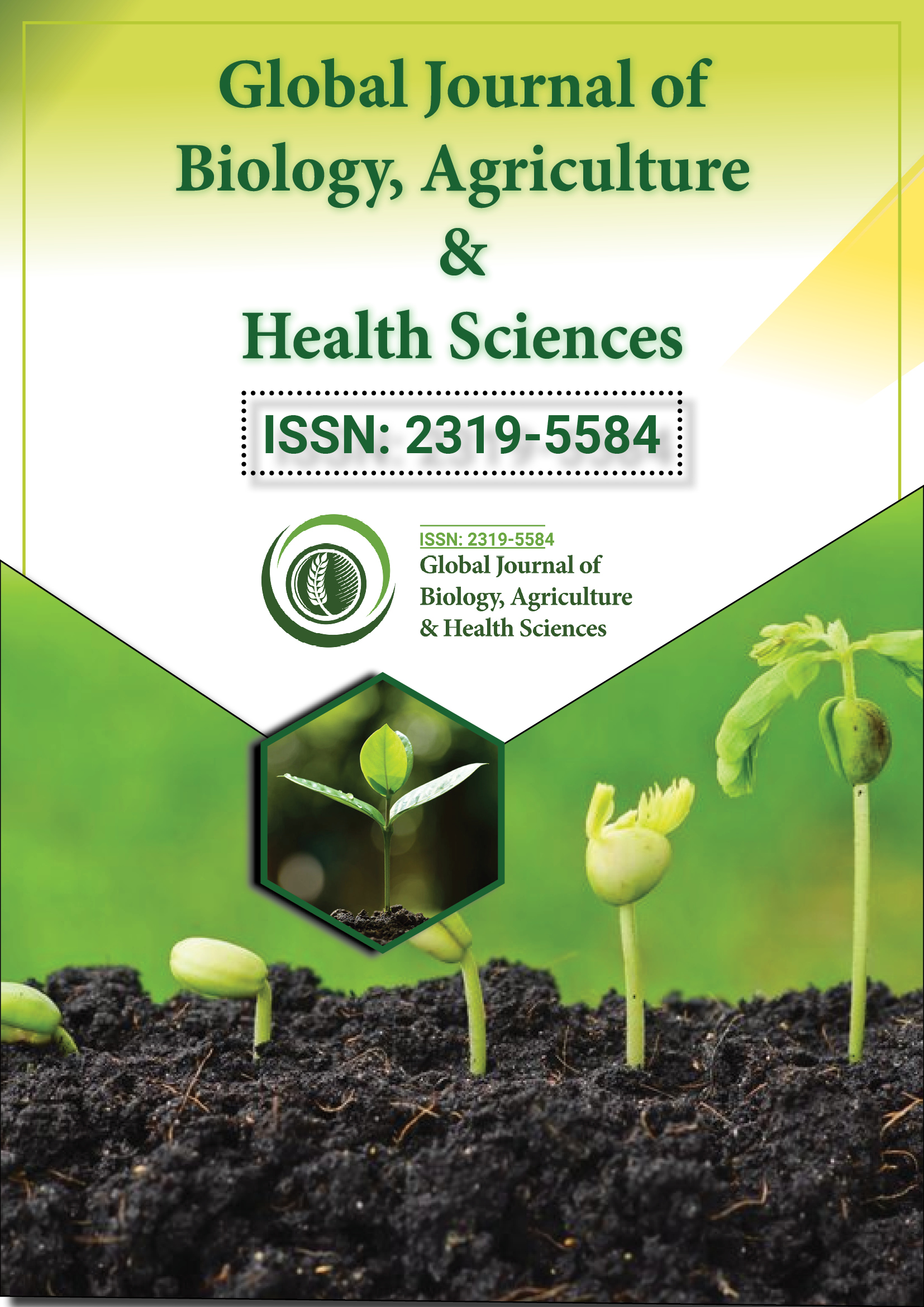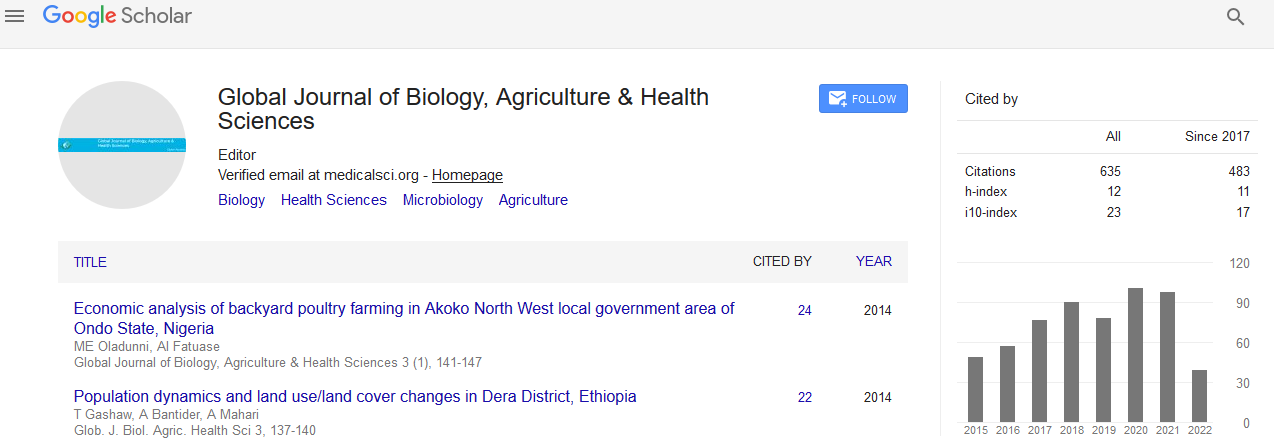Indexed In
- Euro Pub
- Google Scholar
Useful Links
Share This Page
Journal Flyer

Open Access Journals
- Agri and Aquaculture
- Biochemistry
- Bioinformatics & Systems Biology
- Business & Management
- Chemistry
- Clinical Sciences
- Engineering
- Food & Nutrition
- General Science
- Genetics & Molecular Biology
- Immunology & Microbiology
- Medical Sciences
- Neuroscience & Psychology
- Nursing & Health Care
- Pharmaceutical Sciences
Short Communication - (2024) Volume 13, Issue 2
Comprehensive Insights into PSY Gene Family: Regulation, Expression Patterns, and Functional Roles in Carotenoid Biosynthesis across Plant Species
Hiroshi Yamaguchi*Received: 27-May-2024, Manuscript No. GJBAHS-24-26465; Editor assigned: 30-May-2024, Pre QC No. GJBAHS-24-26465 (PQ); Reviewed: 13-Jun-2024, QC No. GJBAHS-24-26465 (QC); Revised: 20-Jun-2024, Manuscript No. GJBAHS-24-26465 (R); Published: 27-Jun-2024, DOI: 10.35248/2319-5584.24.13.227
Description
The Phytoene Synthase (PSY ) gene family plays an important role in the biosynthesis of carotenoids, which are essential pigments contributing to the vibrant colours of many fruits and vegetables, as well as providing critical functions in plant development and stress responses. Carotenoids are also vital precursors for the synthesis of important signalling molecules such as abscisic acid and strigolactones. Roughly 750 carotenoids have been depicted in nature, and that number keeps on developing [1]. Plants draw in bugs and birds for fertilization and seed dispersal, to a great extent in view of carotenoids, which give various varieties to establish parts. Carotenoids also have antioxidant properties and are present in the human diet as the basis for numerous nutrients and the precursor of vitamin A. Albeit these mixtures are fundamental for wellbeing; people can't blend them [2]. 15- cis-phytoene is the first colourless carotenoid produced by PSY, a rate-limiting enzyme in the carotenoid biosynthesis pathway [3,4]. The first step is mediated by PSY , which is encoded in the nuclear genome and is responsible for catalysing the transformation of two GGPP molecules into phytoene in plants [5]. The fact that Arabidopsis mutant etiolated seedlings contain less total carotene is consistent with the fact that galactose is required for PSY activity [6]. There are three to five members of the PSY family in many plant species, but Arabidopsis only has one. Cucurbita pepo contains three PSY genes (CpPSYA, CpPSYB, and CpPSYC), but only the abundance of the CpPSYA transcript influences the carotenoid biosynthetic pathway [7]. Apple, on the other hand, has six MdPSY s, the majority of which are MdPSY1 and MdPSY2, which have relatively high levels of enzymatic activity and expression [8]. Numerous regulatory patterns affected PSY 's function. The expression characteristics that are tissue- specific are also present in various PSY members. PSY1 was only found in the fruits of citrus and tomato [9,10], while PSY2 and PSY3 were mostly found in the leaves and roots. The quieting of SlPSY1 brought about a yellow natural product tone from red. The natural product aggregate didn't obviously change when SlPSY2 and SlPSY3 were hushed, proposing that SlPSY1 assumes the main part in tomato natural product. Tissues with chloroplasts play the main role for SlPSY2 [9]. PSY -A was found in the entire tissue of watermelon, including the fruits, and PSY - B was found in the leaves and roots of watermelon. The transcriptome elements at specific watermelon organic product formative stages proposed that lycopene aggregation influences the up-guideline of ClPSY . Additionally, distinct PSY members were expressed in distinct locations within the chloroplast, such as the envelope membrane and stroma or thylakoid membranes associated with plastoglobules. ZmPSY1 is responsible for the distorted plastid shape and fiber phenotype in maize. Enzyme activity may also be affected by variant localization. PSY enzyme activity was only detected in the membrane-bound form, not in the matrix-localized form, when PSY was overexpressed in Arabidopsis. Another PSY regulator for the accumulation of carotenoids was transcription factor. By interacting with the SlPSY1 promoter, the Ripening-Inhibitor (RIN) in tomato has been shown to regulate fruit carotenoid concentration. SlBBX20 in tomato can actuate the declaration of SlPSY1 by straightforwardly restricting to the G-box theme of its advertiser, bringing about expanded articulation of SlPSY1 for carotenoid amassing, introducing dull green variety in products of the soil. The expression trend of AdMYB7 in N. Benthamiana was found to be in line with that of NdPSY, as demonstrated by transcriptomic data. In citrus callus, CsMADS6 overexpression can directly combine with CsPSY promoters to increase the content of carotenes. Carotenoid pathway products' feedback also regulates PSY expression. Carrots with an overexpression of AtCYP97A had an increase in beta-carotene, which converted into lutein, but a decrease in PSY protein, which resulted in a decrease in carotenoids. Post-transcriptionally, PSY can alter carotenoid accumulation at the protein level. Carotenoid metabolites and total carotenoid content had a negative effect on PSY protein levels. Arabidopsis and potato have OR/OR-like proteins that control PSY expression levels. PIF1 is involved in the formation of chlorophyll and chloroplasts as well as the production of carotene as a PSY post-transcriptional regulator. The orange tissue tone (β-carotene gathered) in melon was impacted by the CmOr (encoding a plastid-designated protein) quality. Further investigation revealed that CmOr had a significant impact on CmPSY1 protein levels while having little effect on CmPSY1 expression. PSY protein transformation decreases when Clp activity in clpc1 decreases. The PSY protein's stability and activity in clpc1 were both improved by the OR protein. PSYs have been extensively studied in other crops to date, but less so in cucurbitaceae, particularly watermelon. Three ClPSY members from the watermelon genome were cloned, the complete protein Coding Sequences (CDS) were analyzed, the expression profiles in various tissues were compared, and the expression patterns during fruit development in fruits of various colors were evaluated in this study. Furthermore, the ClPSY quality family was explored as to chemical action utilizing a heterologous complementation framework. Some PSYs in the genomic synteny may have a similar gene function, as shown by the expression pattern and genomic synteny of various PSY s in the cucurbit crops.
References
- Perkins-Veazie P, Collins JK, Davis AR, Roberts W. Carotenoid Content of 50 Watermelon Cultivars. J Agric Food Chem. 2006;54: 2593-2597.
[Crossref] [Google Scholar] [PubMed]
- Botella-Pavía P, Rodríguez-Concepción M. Carotenoid biotechnology in plants for nutritionally improved foods. Physiol Plant. 2006;126:369-381.
- Yabuzaki J. Carotenoids database: Structures, chemical fingerprints and distribution among organisms. Database. 2017:bax004.
[Crossref] [Google Scholar] [PubMed]
- Hashimoto H, Uragami C, Cogdell RJ. Carotenoids in photosynthesis. Subcell Biochem. 2016;79:111-139.
[Crossref] [Google Scholar] [PubMed]
- Niyogi KK. Photoprotection revisited: Genetic and molecular approaches. Annu Rev Plant Physiol. 1999;50:333-359.
[Crossref] [Google Scholar] [PubMed]
- Clagett-Dame M, Knutson D. Vitamin A in reproduction and development. Nutrients. 2011;3:385-428.
[Crossref] [Google Scholar] [PubMed]
- Cutler SR, Rodriguez PL, Finkelstein RR, Abrams SR. Abscisic acid: Emergence of a core signaling network. Annu Rev Plant Biol. 2010;61:651-679.
[Crossref] [Google Scholar] [PubMed]
- Hou X, Rivers J, León P, McQuinn RP, Pogson BJ. Synthesis and function of apocarotenoid signals in plants. Trends Plant Sci. 2016;21:792-803.
[Crossref] [Google Scholar] [PubMed]
- Loreto F, Pollastri S, Fineschi S, Velikova V. Volatile isoprenoids and their importance for protection against environmental constraints in the Mediterranean area. Env Exp Bot. 2014;103:99-106.
- Fiedor J, Burda K. Potential role of carotenoids as antioxidants in human health and disease. Nutrients 2014;6:466-488.
[Crossref] [Google Scholar] [PubMed]
Citation: Yamaguchi H (2024) Comprehensive Insights into PSY Gene Family: Regulation, Expression Patterns, and Functional Roles in Carotenoid Biosynthesis across Plant Species. Glob J Agric Health Sci. 13.227.
Copyright: © 2024 Yamaguchi H. This is an open-access article distributed under the terms of the Creative Commons Attribution License, which permits unrestricted use, distribution, and reproduction in any medium, provided the original author and source are credited.

